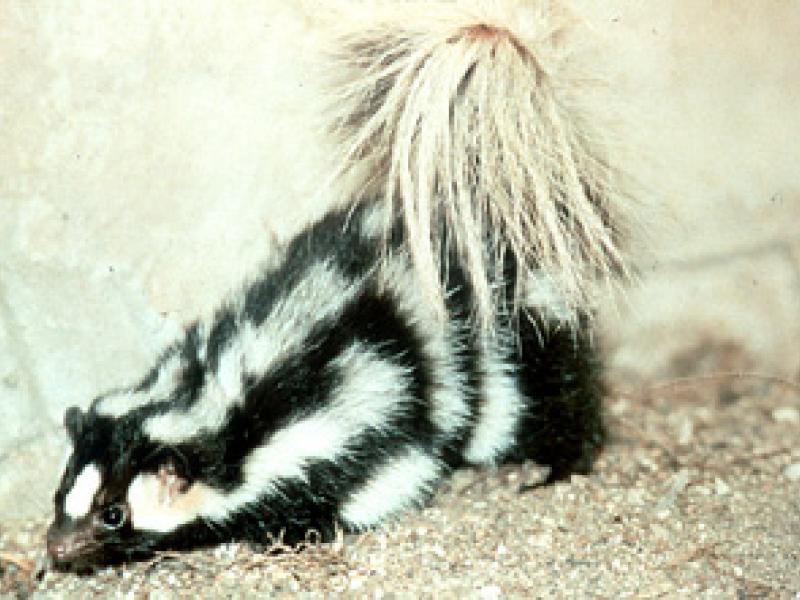Photo on the right courtesy of Damon Lesmiester.
Searching for the Eastern Spotted Skunk Eastern Spotted Skunk Research
SCIENTIFIC NAME:
Spilogale putorius
OTHER NAMES:
Civet cat, polecat, hydrophoby cat.
STATUS:
Found in a variety of habitats such as pastures, woodlands, forest edges, and farmlands. Although statewide in distribution, little known about this species in Alabama. HIGH CONSERVATION CONCERN.
DESCRIPTION:
The eastern spotted skunk is one of two species of skunk that inhabit the southern United States. The spotted skunk is a small, slender animal about the size of a squirrel. The fur is jet black with four to six horizontal white stripes on the neck and shoulders. The name spotted skunk is derived from the irregular elongated, vertical spots that are present along its sides and forelegs. The tail is tipped in white, while the head possesses a white triangular patch above the nose. The average weight of spotted skunks varies from one to one-and-one-half pounds, with males weighing approximately 10 percent more than females. Claws on the front feet are adapted for digging out prey species. The approximate length of the front claws is one-fourth inch -- almost twice the length of the claws on the back feet.
DISTRIBUTION:
The spotted skunk has a somewhat limited distribution in the United States. It ranges from the northern Midwest down through the southeastern states. Localized populations occur along the Gulf Coast of northern Mexico eastward to southern Florida. Distribution maps indicate that this species is not present in the extreme northwestern United States as well as being noticeably absent from the north central and northeastern United States. In Alabama, historical records indicate that this species is statewide in distribution. Recent research conducted by the Wildlife and Freshwater Fisheries Division indicates that there are isolated pockets or populations of spotted skunk throughout the state. Research indicates that the largest population appears to be in the coastal plain region of the southwestern and central portions of Alabama.
HABITAT:
Spotted skunks are found in a variety of habitat types. Stands of mixed pine and hardwoods associated with rocky shrubby areas are preferred. Areas that have extensive expanses of vegetative cover with thickets are all utilized by this species. Habitats that provide for a variety of prey species are prime hunting areas. Den sites are established in locations that provide protection from the elements and allow for a minimal amount of light penetration. Rock piles, rock crevices, brush piles, hollow logs, old abandoned buildings, or under root wads are favorite denning sites.
FEEDING HABITS:
Food habits of the spotted skunk are similar to that of the striped skunk. Diets seem to vary with the seasons. During the summer months, insects such as grasshoppers, crickets, and beetles are eaten. In addition, frogs, crawfish, birds, bird eggs, mice, fruits, and berries are also on the menu. During the winter months their appetite seems to lean toward protein. Mice, young rabbits, birds, and carrion compose approximately 90 percent of the predatory spotted skunk’s winter diet.
LIFE HISTORY AND ECOLOGY:
Breeding season occurs from late March until early April. After a gestation period of 60 to 70 days a litter of two to six (five on the average) young are born. At birth the young are blind, hairless and weigh approximately one-half ounce. The kits are fully furred at 21 days, have their eyes open at 32 days, and start eating soft food at approximately six weeks of age. Young spotted skunks are weaned at eight weeks and at four months are capable of foraging on their own. Primarily nocturnal, these secretive mammals are rarely seen. The spotted skunk’s defense mechanism (musk glands) can be utilized to distract would be attackers. The method of delivery distinguishes spotted skunks from other skunks. When threatened, they will do a handstand, arching their back so they can see the enemy while aiming the scent gland. While in this position they may also stamp their front feet as an additional warning. Intruders ignoring their threatening display are likely to be sprayed with a musk more pungent than that of other skunks. This noxious musk is capable of temporarily impairing the vision of the attacker if it comes in contact with their eyes.
REFERENCES:
Chapman, J.A. and G.A. Feldhamer. 1982. Wild Mammals of North America. The John Hopkins University Press. pp. 1147.
Mitchell, M.S. and M. E. Sievering. 2004. Alabama Wildlife, Volume III. Imperiled Amphibians, Reptiles, Birds and Mammals. University of Alabama Press. pp. 210-211.
Novak, M., J. A. Baker, M. E. Obbard and B. Mallock. 1987. Wildlife Furbearer Management and Conservation in North America. Ontario Ministry of Natural Resources. pp. 1150.
Sievering, M. E. 1989. Furbearers of Alabama. Alabama Department of Conservation and Natural Resources. Special Report No. 11. pp. 78.
Author:
Mike Sievering, Wildlife Biologist, Alabama Division of Wildlife and Freshwater Fisheries







